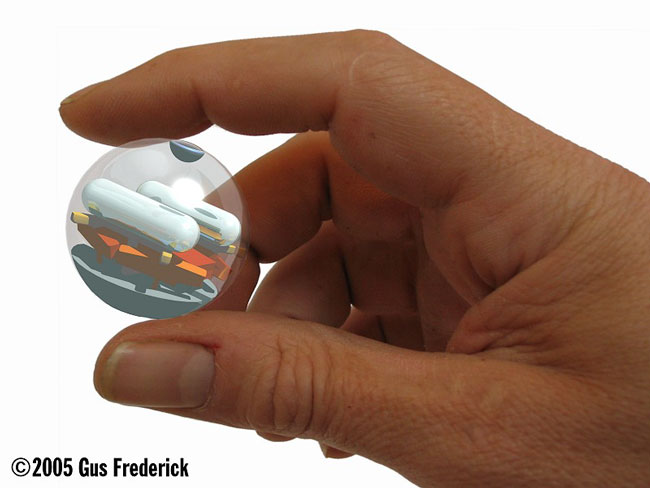Microbot Madness: Hopping Toward Planetary Exploration

The success of NASA's Mars roversSpirit and Opportunity has scored high pointsfor the wheeled automatons, but another plan may one day have their roboticsuccessors hopping.
That plan, according to its researchteam, calls for a swarm of small, spherical robots the size of tennis balls tohop across another world exploring caves, nooks and other crannies that pastmobile robots have been too large to study.
"The individual units are very cuteand very adorable," Penelope Boston, one of two researchers spearheading aneffort to study the hopping microbots, told SPACE.com."But the function of them as an ensemble is where the real strategy lies."
Boston and microbotsprincipal investigator Steven Dubowsky - head of the Field and Space Laboratoryat the Massachusetts Institute of Technology (MIT) - won $400,000 in fundingthis year from the NASA Institute for Advanced Concepts (NIAC) to push theirresearch forward.
"It's rather a unique robotconcept," said Robert Casanova, NIAC director, in a telephone interview. "Mostothers have been either wheeled vehicles or walking or staggering ones. Thehoppers have the advantage of getting into very difficult, tight spaces, say incaves, whereas one of the larger rovers might be cumbersome."
It is precisely the microbots potential for planetary spelunking - on Mars,Earth, the Moon or otherwise - that grabbed Boston's attention.
"I want to try and get into thosekinds of places," said Boston,who directs cave and Karst studies at the New MexicoInstitute of Mining and Technology, adding that they could be a vital tool todetect organisms on Earth or in space. "It's very important to make devices forlife detection on Mars, for example...Any planet or moon with a solid surfacewill do."
Breaking space news, the latest updates on rocket launches, skywatching events and more!
Swarming Mars
A single golf-cart sized Mars roverweighs about 384 pounds (174 kilograms) and includes a sophisticated suite ofcameras, spectrometers and other geological tools to study the red planet'ssurface.
"We (put) about 1,000 of these microbots into that mass," Boston said. "And that would allow a greatdiversity of robots."
The microbotsenvisioned by Dubowsky and Boston would push themselves along using apolymer-based artificial muscle that would kick them about one meter forwardabout once every hour. They would also be capable of carrying a miniaturizedsuite of science instruments, such as cameras, spectrometers or other sensors, that could be tailored for a specific mission.
"The instruments to study the surfacewould be different that if you were aiming at a lava tube," Boston said, adding that a proper fuel celland hardy, resistant shell are vital foundations for a viable microbot system. "They have to be big enough to carry thekind of fuel cell that can power their systems, but not betoo small that they get wedged into everything."
Current plans call for microbots that could be deployed via lander,rover, aerial vehicles, orbital platforms or even an astronaut scattering theautomatons by hand.
An open line
The other benefit of a microbot swarm is redundancy, Boston said.
Not only could a series ofindividual units be lost without compromising a mission's integrity, a networkof functional microbots could provide a vital relaylink to a remote base or orbital craft during subsurface exploration.
"These guys need to keep incommunication with each other," Bostonsaid. "So they could set up a node-to-node communications system a lot like acellular [phone] network. Everybody will know where everybody else is."
From that base, the microbots could eventually be capable of complex behavior,she added.
Earthly cave dwellers
Before they set hopper on anotherworld, microbots will likely make their first jumpsthrough terrestrial caves on Earth, researchers said.
"I think we'll come out of this withunique technology and units that we can test in the lava tube caves here," Boston said. "We'vealready done some testing to look at the size of the units and how they wouldbounce on a rugged surface."
An actual working, instrumented microbot is at least a few years off depending on the levelof funding, but would prove a vital resource in studying hazardous regionswithin Earthly caves, according to Boston.
"One of our caves in New Mexico is sulfuricacid-filled, and others have really small passages that humans can't get into,"she said. "I can't wait to have my own fleet of these guys."

Tariq is the award-winning Editor-in-Chief of Space.com and joined the team in 2001. He covers human spaceflight, as well as skywatching and entertainment. He became Space.com's Editor-in-Chief in 2019. Before joining Space.com, Tariq was a staff reporter for The Los Angeles Times covering education and city beats in La Habra, Fullerton and Huntington Beach. He's a recipient of the 2022 Harry Kolcum Award for excellence in space reporting and the 2025 Space Pioneer Award from the National Space Society. He is an Eagle Scout and Space Camp alum with journalism degrees from the USC and NYU. You can find Tariq at Space.com and as the co-host to the This Week In Space podcast on the TWiT network. To see his latest project, you can follow Tariq on Twitter @tariqjmalik.
